Abstract
The two internal transcribed spacers (ITS1 and ITS2) of rDNA of three members of the Ixodes ricinus "complex" (Acari: Ixodidae) were sequenced. Sequence variation was assessed for the North American species I. scapularis, I. dammini, and I. pacificus at three levels: within individual/population, between individuals of different geographic origin within a species, and between species. Both spacers are highly variable, particularly with regard to small deletions and additions which may arise via replication slippage. Homogenization of rDNA multigene arrays for particular sequence variants appears to occur at a relatively rapid rate, since I. pacificus sequences differ from the others at numerous invariant sites, facilitating the use of these sequences to assess sibling species relationships. Based on maximum parsimony and two distance methods (unweighted pair-group with arithmetic means and neighbor-joining), sequence variation in ITS1 and ITS2 suggests that I. scapularis and I. dammini are not distinct species and that even individuals from geographically isolated locations are very similar. Individuals from geographically separated populations of I. pacificus appear to be relatively less closely related to each other but distinct from those of I. scapularis/dammini. In I. scapularis/dammini, diversity within and between individuals from geographic populations contributed equally to total sequence diversity.
Full text
PDF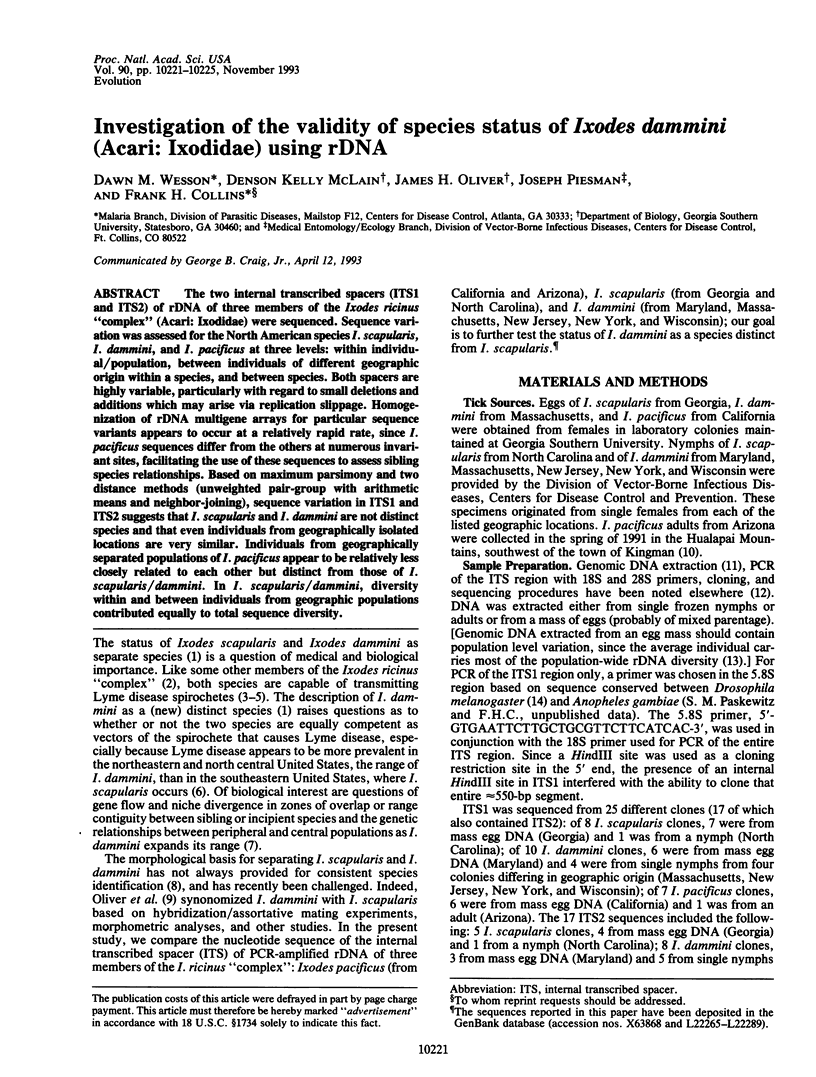
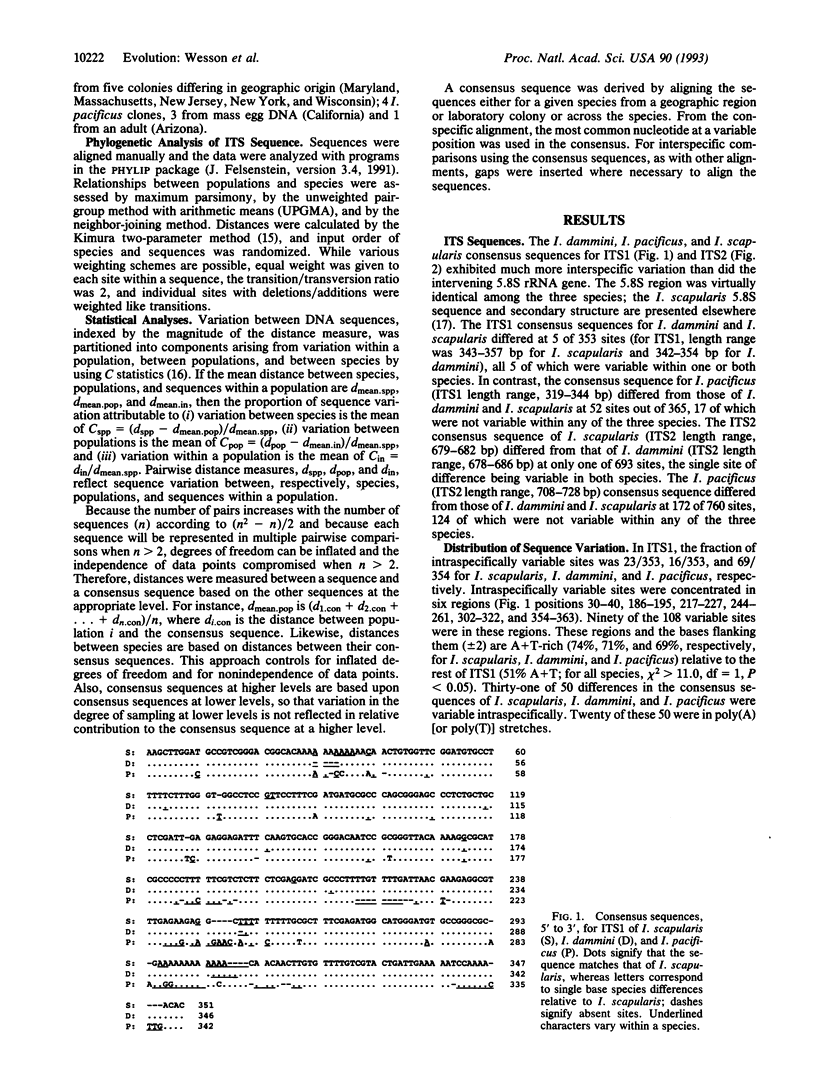
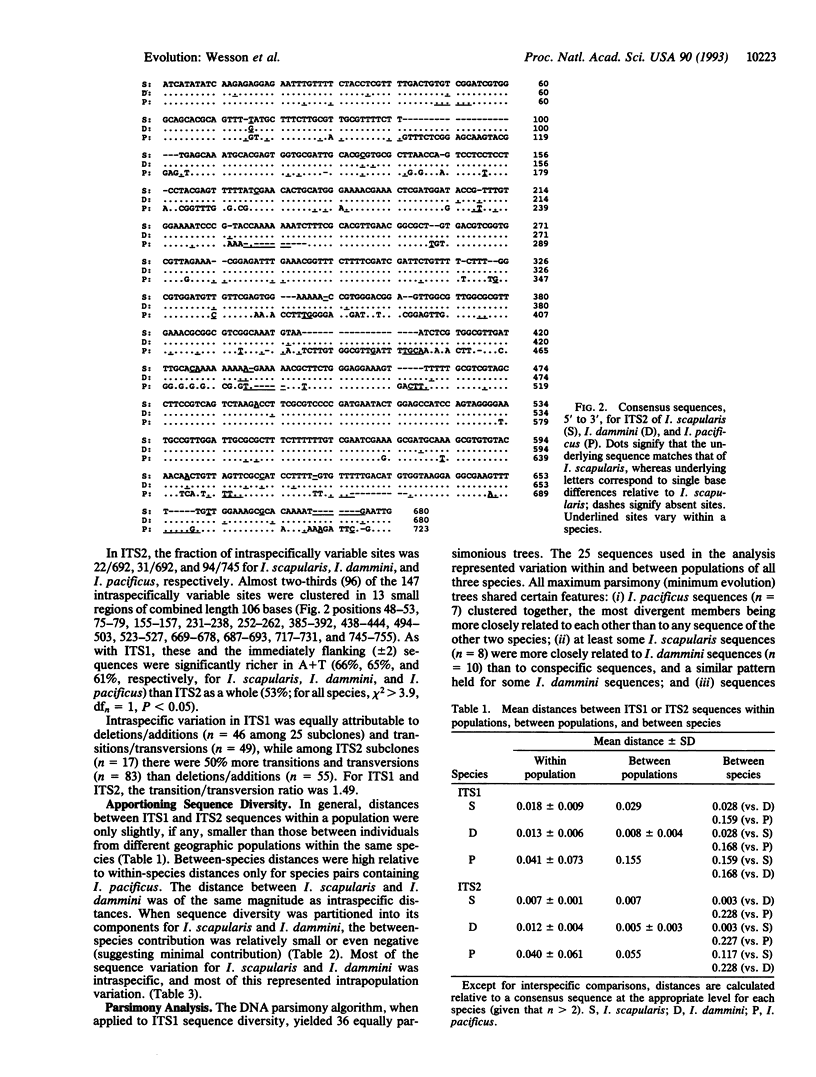
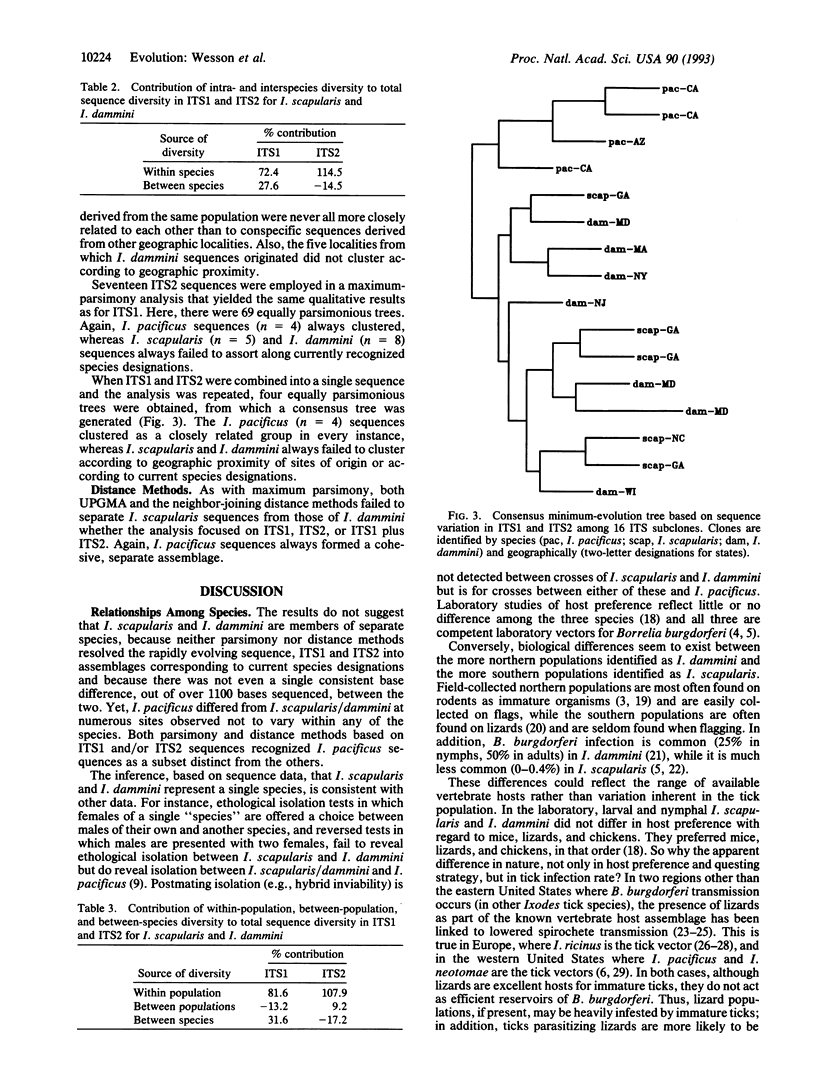
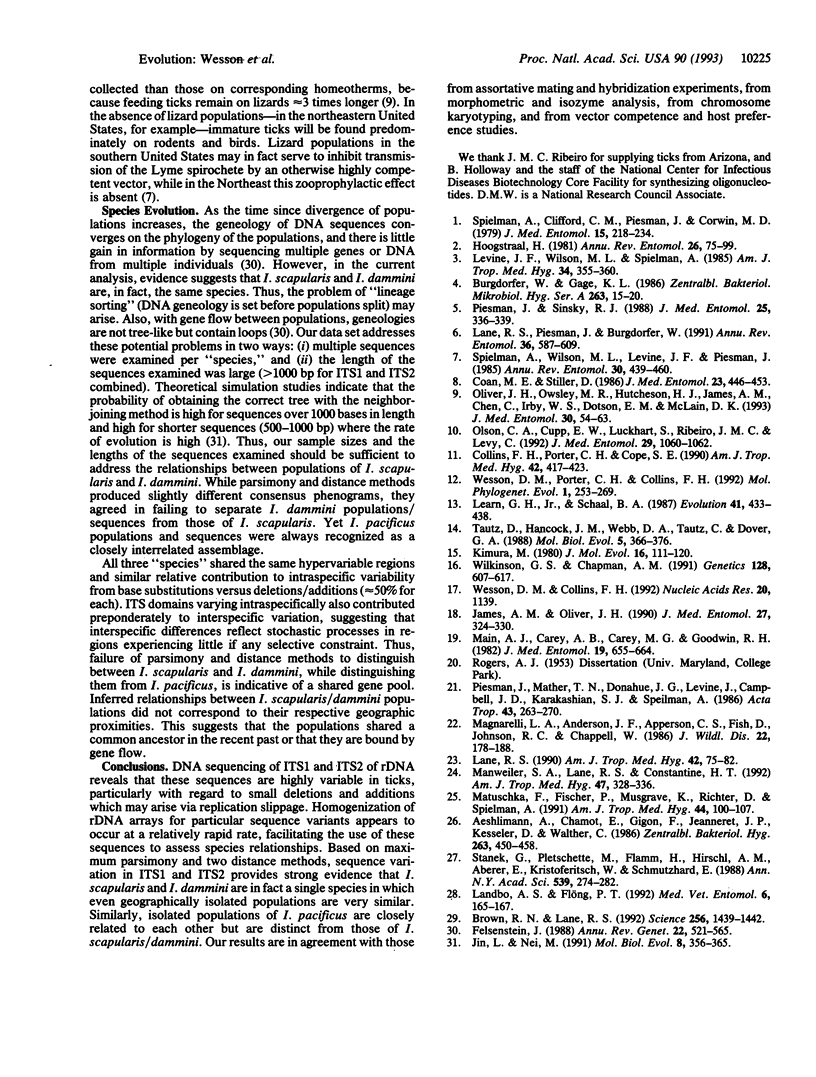
Selected References
These references are in PubMed. This may not be the complete list of references from this article.
- Aeschlimann A., Chamot E., Gigon F., Jeanneret J. P., Kesseler D., Walther C. B. burgdorferi in Switzerland. Zentralbl Bakteriol Mikrobiol Hyg A. 1987 Feb;263(3):450–458. doi: 10.1016/s0176-6724(87)80107-4. [DOI] [PubMed] [Google Scholar]
- Brown R. N., Lane R. S. Lyme disease in California: a novel enzootic transmission cycle of Borrelia burgdorferi. Science. 1992 Jun 5;256(5062):1439–1442. doi: 10.1126/science.1604318. [DOI] [PubMed] [Google Scholar]
- Burgdorfer W., Gage K. L. Susceptibility of the black-legged tick, Ixodes scapularis, to the Lyme disease spirochete, Borrelia burgdorferi. Zentralbl Bakteriol Mikrobiol Hyg A. 1986 Dec;263(1-2):15–20. doi: 10.1016/s0176-6724(86)80096-7. [DOI] [PubMed] [Google Scholar]
- Coan M. E., Stiller D. Ixodes dammini (Acari: Ixodidae) in Maryland, USA, and a preliminary survey for Babesia microti. J Med Entomol. 1986 Jul 28;23(4):446–453. doi: 10.1093/jmedent/23.4.446. [DOI] [PubMed] [Google Scholar]
- Collins F. H., Porter C. H., Cope S. E. Comparison of rDNA and mtDNA in the sibling species Anopheles freeborni and A. hermsi. Am J Trop Med Hyg. 1990 May;42(5):417–423. doi: 10.4269/ajtmh.1990.42.417. [DOI] [PubMed] [Google Scholar]
- Felsenstein J. Phylogenies from molecular sequences: inference and reliability. Annu Rev Genet. 1988;22:521–565. doi: 10.1146/annurev.ge.22.120188.002513. [DOI] [PubMed] [Google Scholar]
- Hoogstraal H. Changing patterns of tickborne diseases in modern society. Annu Rev Entomol. 1981;26:75–99. doi: 10.1146/annurev.en.26.010181.000451. [DOI] [PubMed] [Google Scholar]
- James A. M., Oliver J. H., Jr Feeding and host preference of immature Ixodes dammini, I. scapularis, and I. pacificus (Acari: Ixodidae). J Med Entomol. 1990 May;27(3):324–330. doi: 10.1093/jmedent/27.3.324. [DOI] [PubMed] [Google Scholar]
- Kimura M. A simple method for estimating evolutionary rates of base substitutions through comparative studies of nucleotide sequences. J Mol Evol. 1980 Dec;16(2):111–120. doi: 10.1007/BF01731581. [DOI] [PubMed] [Google Scholar]
- Landbo A. S., Flöng P. T. Borrelia burgdorferi infection in Ixodes ricinus from habitats in Denmark. Med Vet Entomol. 1992 Apr;6(2):165–167. doi: 10.1111/j.1365-2915.1992.tb00596.x. [DOI] [PubMed] [Google Scholar]
- Lane R. S., Piesman J., Burgdorfer W. Lyme borreliosis: relation of its causative agent to its vectors and hosts in North America and Europe. Annu Rev Entomol. 1991;36:587–609. doi: 10.1146/annurev.en.36.010191.003103. [DOI] [PubMed] [Google Scholar]
- Lane R. S. Susceptibility of the western fence lizard (Sceloporus occidentalis) to the Lyme borreliosis spirochete (Borrelia burgdorferi). Am J Trop Med Hyg. 1990 Jan;42(1):75–82. doi: 10.4269/ajtmh.1990.42.75. [DOI] [PubMed] [Google Scholar]
- Levine J. F., Wilson M. L., Spielman A. Mice as reservoirs of the Lyme disease spirochete. Am J Trop Med Hyg. 1985 Mar;34(2):355–360. doi: 10.4269/ajtmh.1985.34.355. [DOI] [PubMed] [Google Scholar]
- Lin J., Nei M. Relative efficiencies of the maximum-parsimony and distance-matrix methods of phylogeny construction for restriction data. Mol Biol Evol. 1991 May;8(3):356–365. doi: 10.1093/oxfordjournals.molbev.a040648. [DOI] [PubMed] [Google Scholar]
- Magnarelli L. A., Anderson J. F., Apperson C. S., Fish D., Johnson R. C., Chappell W. A. Spirochetes in ticks and antibodies to Borrelia burgdorferi in white-tailed deer from Connecticut, New York State, and North Carolina. J Wildl Dis. 1986 Apr;22(2):178–188. doi: 10.7589/0090-3558-22.2.178. [DOI] [PubMed] [Google Scholar]
- Main A. J., Carey A. B., Carey M. G., Goodwin R. H. Immature Ixodes dammini (acari: Ixodidae) on small animals in Connecticut, USA. J Med Entomol. 1982 Nov 30;19(6):655–664. doi: 10.1093/jmedent/19.6.655. [DOI] [PubMed] [Google Scholar]
- Manweiler S. A., Lane R. S., Tempelis C. H. The western fence lizard Sceloporus occidentalis: evidence of field exposure to Borrelia burgdorferi in relation to infestation by Ixodes pacificus (Acari: Ixodidae). Am J Trop Med Hyg. 1992 Sep;47(3):328–336. doi: 10.4269/ajtmh.1992.47.328. [DOI] [PubMed] [Google Scholar]
- Matuschka F. R., Fischer P., Musgrave K., Richter D., Spielman A. Hosts on which nymphal Ixodes ricinus most abundantly feed. Am J Trop Med Hyg. 1991 Jan;44(1):100–107. doi: 10.4269/ajtmh.1991.44.100. [DOI] [PubMed] [Google Scholar]
- Oliver J. H., Jr, Owsley M. R., Hutcheson H. J., James A. M., Chen C., Irby W. S., Dotson E. M., McLain D. K. Conspecificity of the ticks Ixodes scapularis and I. dammini (Acari: Ixodidae). J Med Entomol. 1993 Jan;30(1):54–63. doi: 10.1093/jmedent/30.1.54. [DOI] [PubMed] [Google Scholar]
- Olson C. A., Cupp E. W., Luckhart S., Ribeiro J. M., Levy C. Occurrence of Ixodes pacificus (Parasitiformes: Ixodidae) in Arizona. J Med Entomol. 1992 Nov;29(6):1060–1062. doi: 10.1093/jmedent/29.6.1060. [DOI] [PubMed] [Google Scholar]
- Piesman J., Mather T. N., Donahue J. G., Levine J., Campbell J. D., Karakashian S. J., Spielman A. Comparative prevalence of Babesia microti and Borrelia burgdorferi in four populations of Ixodes dammini in eastern Massachusetts. Acta Trop. 1986 Sep;43(3):263–270. [PubMed] [Google Scholar]
- Piesman J., Sinsky R. J. Ability to Ixodes scapularis, Dermacentor variabilis, and Amblyomma americanum (Acari: Ixodidae) to acquire, maintain, and transmit Lyme disease spirochetes (Borrelia burgdorferi). J Med Entomol. 1988 Sep;25(5):336–339. doi: 10.1093/jmedent/25.5.336. [DOI] [PubMed] [Google Scholar]
- Spielman A., Clifford C. M., Piesman J., Corwin M. D. Human babesiosis on Nantucket Island, USA: description of the vector, Ixodes (Ixodes) dammini, n. sp. (Acarina: Ixodidae). J Med Entomol. 1979 Mar 23;15(3):218–234. doi: 10.1093/jmedent/15.3.218. [DOI] [PubMed] [Google Scholar]
- Spielman A., Wilson M. L., Levine J. F., Piesman J. Ecology of Ixodes dammini-borne human babesiosis and Lyme disease. Annu Rev Entomol. 1985;30:439–460. doi: 10.1146/annurev.en.30.010185.002255. [DOI] [PubMed] [Google Scholar]
- Stanek G., Pletschette M., Flamm H., Hirschl A. M., Aberer E., Kristoferitsch W., Schmutzhard E. European Lyme borreliosis. Ann N Y Acad Sci. 1988;539:274–282. doi: 10.1111/j.1749-6632.1988.tb31861.x. [DOI] [PubMed] [Google Scholar]
- Tautz D., Hancock J. M., Webb D. A., Tautz C., Dover G. A. Complete sequences of the rRNA genes of Drosophila melanogaster. Mol Biol Evol. 1988 Jul;5(4):366–376. doi: 10.1093/oxfordjournals.molbev.a040500. [DOI] [PubMed] [Google Scholar]
- Wesson D. M., Collins F. H. Sequence and secondary structure of 5.8S rRNA in the tick, Ixodes scapularis. Nucleic Acids Res. 1992 Mar 11;20(5):1139–1139. doi: 10.1093/nar/20.5.1139. [DOI] [PMC free article] [PubMed] [Google Scholar]
- Wesson D. M., Porter C. H., Collins F. H. Sequence and secondary structure comparisons of ITS rDNA in mosquitoes (Diptera: Culicidae). Mol Phylogenet Evol. 1992 Dec;1(4):253–269. doi: 10.1016/1055-7903(92)90001-w. [DOI] [PubMed] [Google Scholar]
- Wilkinson G. S., Chapman A. M. Length and sequence variation in evening bat D-loop mtDNA. Genetics. 1991 Jul;128(3):607–617. doi: 10.1093/genetics/128.3.607. [DOI] [PMC free article] [PubMed] [Google Scholar]


